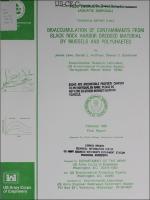Please use this identifier to cite or link to this item:
https://hdl.handle.net/11681/6438Full metadata record
| DC Field | Value | Language |
|---|---|---|
| dc.contributor | Environmental Research Laboratory (Narragansett, R.I.) | - |
| dc.contributor | United States. Environmental Protection Agency | - |
| dc.contributor | Field Verification Program (Aquatic Disposal) | - |
| dc.contributor.author | Lake, James L. | - |
| dc.contributor.author | Hoffman, Gerald L. | - |
| dc.contributor.author | Schimmel, Steven Charles, 1946- | - |
| dc.date.accessioned | 2016-03-23T19:58:38Z | - |
| dc.date.available | 2016-03-23T19:58:38Z | - |
| dc.date.issued | 1985-02 | - |
| dc.identifier.uri | http://hdl.handle.net/11681/6438 | - |
| dc.description | Technical Report | - |
| dc.description | Abstract: Mussels (Mytilus edulis) and worms (Nereis virens) were exposed in laboratory studies to dredged material from Black Rock Harbor (BRH), Connecticut, to examine the bioaccumulation of organic and inorganic contaminants. Mussels were exposed in a dosing system designed to maintain a constant concentration of suspended particulates and food (algae) in seawater. Control mussels received only food (algae). Monitoring of concentrations of organic and inorganic contaminants showed that the system maintained constant concentrations during exposure. Exposed mussels accumulated organic compounds and some inorganic elements, reaching steady-state values between the first and second weeks of exposure. During the 28-day exposure period, mussels showed increases in concentration of two to three orders of magnitude for organic contaminants, but those metals accumulated showed increases of less than a factor of 12. In general, the depuration of organic contaminants was rapid during the first week of depuration, and the depuration rate was inversely related to the compound's n-octanol/water partition coefficient. After the first week depuration rates decreased, and concentrations of most organic compounds remained above control values to the end of the 5-week depuration period. Iron and chromium depurated to control levels within a 2-week period. The polychaete worm N. virens was exposed to BRR bedded sediment in glass aquaria maintained under flowing seawater. Other worms were maintained in reference sediments. Worms exposed for 28 days accumulated polychlorinated biphenyls (PCBs) and polycyclic aromatic hydrocarbons (PARs) to concentrations one to three orders of magnitude above those found in the reference organisms. Of the metals determined, only Cr and Cu were found to accumulate to concentrations higher than those in the reference worms. Concentrations of PCBs exposed to BRR sediment did not decrease during a 28-day depuration period in reference sediments, but depuration of PARs was apparent. Chromium and copper depurated to control levels after 2 weeks. Bioaccumulation factors for PCBs calculated for mussels and worms, when total exposure concentrations were normalized to a gram dry weight sediment basis, were generally within a factor of 1.5. This suggests that modeling bioaccumulation of some organic compounds as a partitioning of contaminants between sediments and organisms may have promise as a generalized predictive technique. | - |
| dc.publisher | Environmental Laboratory (U.S.) | - |
| dc.publisher | Engineer Research and Development Center (U.S.) | - |
| dc.relation | http://acwc.sdp.sirsi.net/client/en_US/search/asset/1036521 | - |
| dc.rights | Approved for public release; distribution is unlimited. | - |
| dc.source | This Digital Resource was created from scans of the Print Resource | - |
| dc.subject | Absorption | - |
| dc.subject | Physiology | - |
| dc.subject | Dredged material | - |
| dc.subject | Dredging spoil | - |
| dc.subject | Marine pollution | - |
| dc.subject | Aquatic pollution | - |
| dc.subject | Water quality | - |
| dc.subject | Polychlorinated biphenyls | - |
| dc.subject | PCB | - |
| dc.subject | Polycyclic aromatic hydrocarbons | - |
| dc.subject | PAH | - |
| dc.subject | Bioaccumulation | - |
| dc.subject | Biology | - |
| dc.subject | Black Rock Harbor | - |
| dc.subject | Bridgeport | - |
| dc.subject | Connecticut | - |
| dc.subject | Environmental effects | - |
| dc.title | Bioaccumulation of contaminants from Black Rock Harbor dredged materials by mussels and polychaetes | - |
| dc.type | Report | en_US |
| Appears in Collections: | Technical Report | |
Files in This Item:
| File | Description | Size | Format | |
|---|---|---|---|---|
| TR-D-85-2.pdf | 22.02 MB | Adobe PDF |  View/Open |